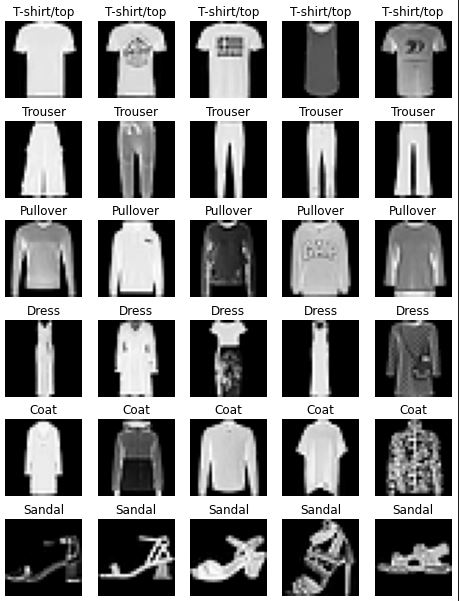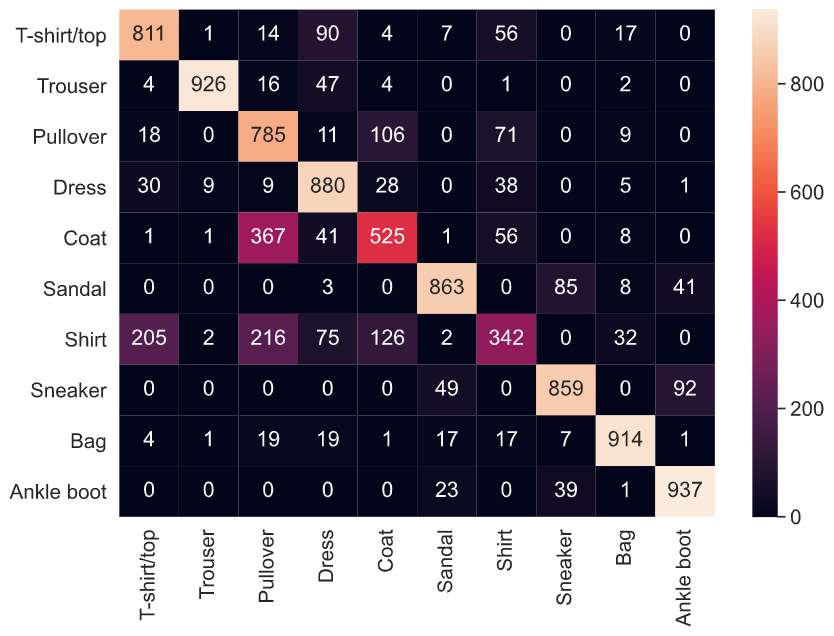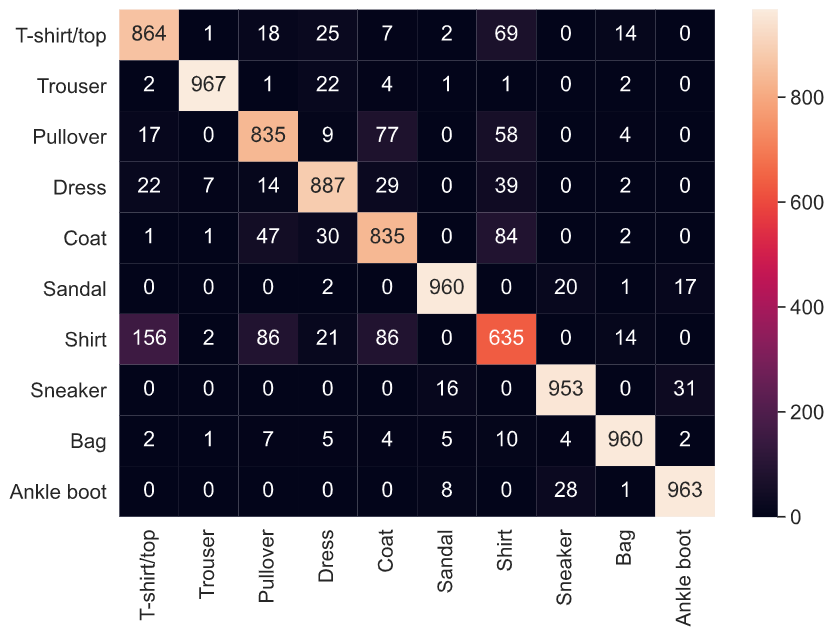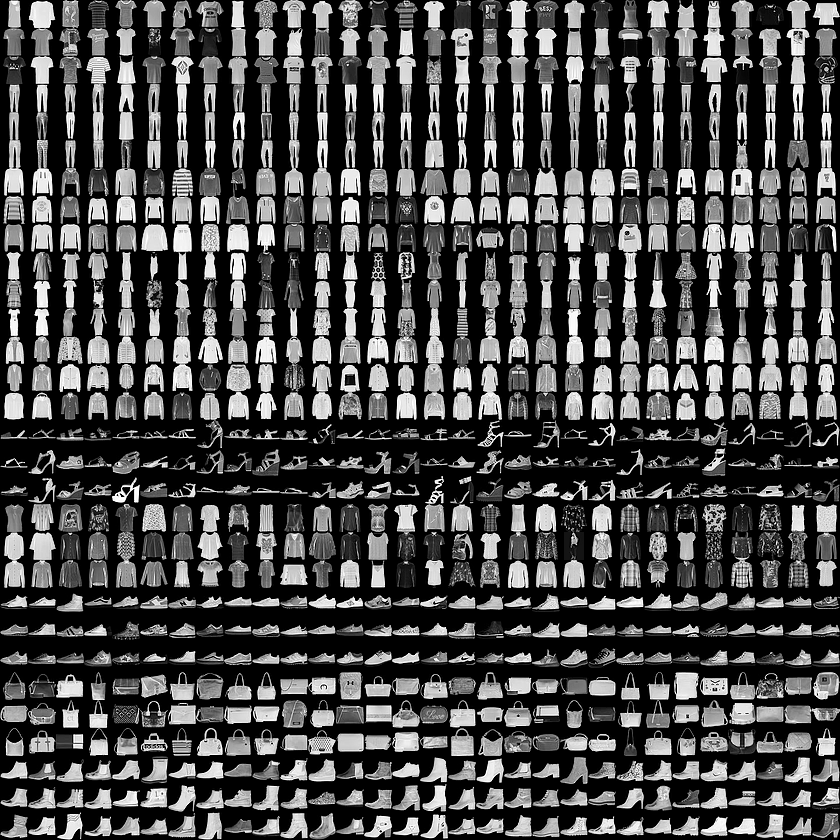The next project was completed using the Fashion-MNIST dataset and PyTorch to build a neural network. There is a GitHub link to a notebook with a more detailed version of this project provided at the bottom.
PyTorch was something I had not previously explored so I decided this image classification problem would be a good use-case to try it out.
Load the dataset and explore
The first thing I did was use the data loaders to load in the data and normalise it all. This was achieved as follows.
#Set a batch size, this is 0.2% of training data
#Ideally I wanted this higher but I had memory errors
batchSize=10
#Create a transformer to normalize the image
transform = transforms.Compose([transforms.ToTensor(), transforms.Normalize((0.5,), (0.5,))])
#Load the training data
trainset = datasets.FashionMNIST(root='./data', train=True,
download=True, transform=transform)
trainloader = torch.utils.data.DataLoader(trainset, batch_size=batchSize,
shuffle=True, num_workers=2)
#This trainloader doesn't shuffle so it can be used for working out training accuracy
trainloader_ns = torch.utils.data.DataLoader(trainset, batch_size=batchSize,
shuffle=False, num_workers=2)
#Load the test data
testset = datasets.FashionMNIST(root='./data', train=False,
download=True, transform=transform)
testloader = torch.utils.data.DataLoader(testset, batch_size=batchSize,
shuffle=False, num_workers=2)
#Create the class labels
classes = ('T-shirt/top', 'Trouser', 'Pullover', 'Dress', 'Coat', 'Sandal', 'Shirt', 'Sneaker', 'Bag', 'Ankle boot')
I then used matplotlib to print out some examples and observe what they looked like in the grey scale.
#Create figure
fig = plt.figure(figsize=(8,18))
columns = 5
rows = 10
#Set some lists to append to
image_list = []
class_list = []
#Loop thorugh each class
for cl in classes:
class_count = 0
#While we haven't found 5 of that class, loop and add images
while class_count < 5:
img_xy = np.random.randint(len(trainset))
if cl == classes[trainset[img_xy][1]]:
img = trainset[img_xy][0][0,:,:]
image_list.append(img)
class_list.append(cl)
class_count += 1
#Display the images
for i in range(1, columns*rows +1):
fig.add_subplot(rows, columns, i)
plt.axis('off')
plt.title(class_list[i-1])
plt.imshow(image_list[i-1], cmap='gray')
plt.show()

The two things I decided to try were a logistic regression class and then a Convolutional Neural Network on the data. I will start with the Logistic Regression.
Logistic Regression
Logistic Regression can be modeled as an extremly simple neural network with just one node inside of it. I impletemendted this with the following class using PyTorch. This code defines the network, creates the pass forward method, a train method which calls this forward method and finally a method to call predictions on with a trained version of it’s self.
class LogisticRegression(torch.nn.Module):
#Create the model with one basic layer, 10 class outputs
def __init__(self):
super(LogisticRegression, self).__init__()
self.linear = torch.nn.Linear(28*28, 10)
#Create our forward pass learning step
def forward(self, x):
#Flatten the image
x = x.reshape(-1, 784)
y_pred = torch.sigmoid(self.linear(x))
return y_pred
#Train the model with the batch
def train(self, batch, criterion):
#Split the batch
images, labels = batch
#Generate the predictions
y_pred = self(images)
#Calcualte our loss
loss = criterion(y_pred, labels)
return loss
#Get the predictions of a dataset using the model
def get_all_preds(self, data):
with torch.no_grad():
total_preds = []
for batch in data:
images, labels = batch
y_pred = self(images)
_, predicted = torch.max(y_pred, 1)
predicted = predicted.numpy()
total_preds.append(predicted)
return np.concatenate(total_preds).ravel()
I needed a few more things before I could implement this class and these were a way to fit the model, calculate accuracy and generate a confusion matrix.
#Train the model and return it for use
def fit(model, criterion, epochs, optimizer, x_data):
running_loss = 0.0
time1 = datetime.datetime.now()
for epoch in range(epochs):
for batch in x_data:
optimizer.zero_grad()
#Train the model
loss = model.train(batch, criterion)
#Backprop
loss.backward()
optimizer.step()
# print statistics
running_loss += loss.item()
print(running_loss)
running_loss = 0.0
print('Finished Training!')
#Calculate time taken
time2 = datetime.datetime.now()
time_taken = time2-time1
time_list.append(time_taken)
print("M3 - Time taken to train is:", (time_taken))
#Calcualte the number of model params
model_parameters = filter(lambda p: p.requires_grad, model.parameters())
params_count = sum([np.prod(p.size()) for p in model_parameters])
print("M4 - Total trainable params is:", params_count)
params_count_list.append(params_count)
return model
#Given two sets of labels as numpy arrays, give accuracy score
def accuracy(predictions, labels):
total = 0
correct = 0
for i in range(predictions.shape[0]):
if predictions[i] == labels[i]:
correct += 1
total += 1
acc_str = "The accuracy is: " + str((correct/total)*100) + "%"
return acc_str
#Given two sets of labels as numpy arrays, create and show a CM
def conf_matrix(ground_truth, predictions):
cm = confusion_matrix(ground_truth, predictions)
df_cm = pd.DataFrame(cm, classes, classes)
plt.figure(figsize=(10,7))
sn.set(font_scale=1.4) # for label size
sn.heatmap(df_cm, annot=True, annot_kws={"size": 16}, fmt='g') # font size
plt.show()
Now all of this was in place I simply created an object of the class, chose Stochastic Gradient Descent to optimise with, set the loss function as Cross Entropy, trained the model and returned the results.
#Create the class
LR = LogisticRegression()
#Set my optimizer as Stocastic Gradient Descent and set hyper params
optimizerLR = optim.SGD(LR.parameters(), lr=0.001, momentum=0.9)
#Set the criterion
criterionLR = nn.CrossEntropyLoss()
#Train the model
epochs = 5
train_model = fit(LR, criterionLR, epochs, optimizerLR,trainloader)
#Get the predictions needed for results
train_output = train_model.get_all_preds(trainloader_ns)
test_output = train_model.get_all_preds(testloader)
#Get ground truth labels
x_true = (trainset.targets).numpy()
y_true = (testset.targets).numpy()
#Print asked for results
test_acc = accuracy(test_output,y_true)
print("M2", test_acc)
#print Confusion Matrix
conf_matrix(y_true, test_output)
This gave me an accuracy of around 80% in 40 seconds of training time and just 5 epochs, below I will show the confusion matrix generated with seaborn.

These results were a good start but I decided to go one step further and use a CNN.
Convolutional Neural Network
I started again by generating the class that I would need.
#Create a CNN class to use for part A
class CNN(nn.Module):
def __init__(self):
super(CNN, self).__init__()
self.conv1 = nn.Conv2d(1, 8, 5) #3: #input channels; 6: #output channels; 5: kernel size
self.pool = nn.MaxPool2d(2, 2)
self.conv2 = nn.Conv2d(8, 16, 5)
self.fc1 = nn.Linear(16 * 4 * 4, 200)
self.fc2 = nn.Linear(200, 10)
def forward(self, x):
x = self.pool(F.tanh(self.conv1(x)))
x = self.pool(F.tanh(self.conv2(x)))
x = x.view(-1, 16 * 4 * 4)
x = F.tanh(self.fc1(x))
x = self.fc2(x)
return x
#Train the model with the batch
def train(self, batch, criterion):
#Split the batch
images, labels = batch
#Generate the predictions
y_pred = self(images)
#Calcualte our loss
loss = criterion(y_pred, labels)
return loss
#Get the predictions of a dataset using the model
def get_all_preds(self, data):
with torch.no_grad():
total_preds = []
for batch in data:
images, labels = batch
y_pred = self(images)
_, predicted = torch.max(y_pred, 1)
predicted = predicted.numpy()
total_preds.append(predicted)
return np.concatenate(total_preds).ravel()
I already had the utility functions from above so I again set my optimiser and the loss and trained the model in the exact same way.
myCNN = CNN()
#Set my optimizer as Stocastic Gradient Descent and set hyper params
optimizerCNN = optim.SGD(myCNN.parameters(), lr=0.001, momentum=0.9)
#Set the criterion
criterionCNN = nn.CrossEntropyLoss()
#Train the model
epochs = 5
train_model = fit(myCNN, criterionCNN, epochs, optimizerCNN, trainloader)
#Get the predictions needed for results
train_output = train_model.get_all_preds(trainloader_ns)
test_output = train_model.get_all_preds(testloader)
#Get ground truth labels
x_true = (trainset.targets).numpy()
y_true = (testset.targets).numpy()
#Print asked for results
test_acc = accuracy(test_output,y_true)
print("M2", test_acc)
#print Confusion Matrix
conf_matrix(y_true, test_output)
This created a much higher score of 89% in just 2 minutes of training and produced the following confusion matrix.

Conclusion
PyTorch is great? Tensors are totally fantastic and the way it supports itself by calculating back-prop extremely quickly allows CNN’s to be built and work extremely quickly without much training at all. I learnt effective ways of using this package to optimise and solve a quick supervised learning project with it.
